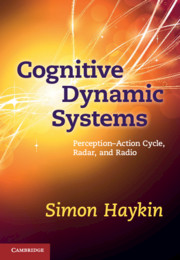Book contents
- Frontmatter
- Contents
- Preface
- Acknowledgments
- 1 Introduction
- 2 The perception–action cycle
- 3 Power-spectrum estimation for sensing the environment
- 4 Bayesian filtering for state estimation of the environment
- 5 Dynamic programming for action in the environment
- 6 Cognitive radar
- 7 Cognitive radio
- 8 Epilogue
- Glossary
- References
- Index
2 - The perception–action cycle
Published online by Cambridge University Press: 05 June 2012
- Frontmatter
- Contents
- Preface
- Acknowledgments
- 1 Introduction
- 2 The perception–action cycle
- 3 Power-spectrum estimation for sensing the environment
- 4 Bayesian filtering for state estimation of the environment
- 5 Dynamic programming for action in the environment
- 6 Cognitive radar
- 7 Cognitive radio
- 8 Epilogue
- Glossary
- References
- Index
Summary
In Chapter 1 of his book entitled Cortex and Mind: Unifying Cognition, Fuster (2003) introduces a new term called the cognit, which is used to characterize the cognitive structure of a cortical network; it is defined as follows:
A cognit is an item of knowledge about the world, the self, or the relations between them. Its network structure is made up of elementary representations of perception or action that have been associated with one another by learning or past experience.
Towards the end of Chapter 1 of the book, Fuster goes on to say:
… perception is part of the acquisition and retrieval of memory, memory stores information acquired by perception, language and memory depend on each other; language and reasoning are special forms of cognitive action; attention serves all other functions; intelligence is served by all; and so on.
These two quotes taken from Fuster's book provide us with a cohesive statement on the cortical functions of cognition in the human brain; both are important. In particular, the second quotation highlights the interrelationships between the five processes involved in cognition: perception, memory, attention, language, and intelligence. Just as language plays a distinctive role in the human brain, so it is in a cognitive dynamic system where language provides the means for effective and efficient communication among the different parts of the system. However, language is outside the scope of this book.
- Type
- Chapter
- Information
- Cognitive Dynamic SystemsPerception-action Cycle, Radar and Radio, pp. 14 - 42Publisher: Cambridge University PressPrint publication year: 2012
- 1
- Cited by



